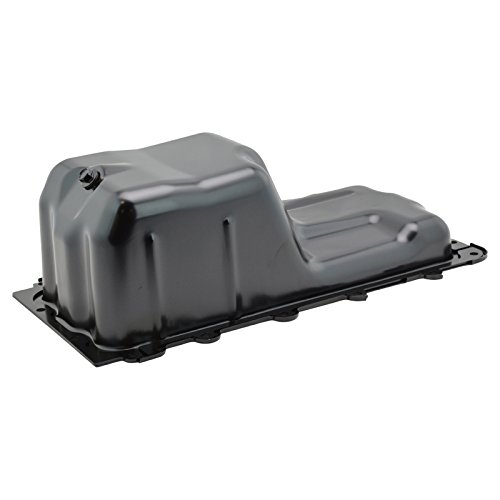Ford’s 2.7 EcoBoost engine is one of the most recent releases from Ford since its EcoBoost engines series.
Its power and acceleration speed is among the best too. Its reliability is also considerable hence a great choice when buying a vehicle.
However, despite being it, it also has its drawbacks. That’s what this article wants to discuss.
We will be looking at the most common Ford 2.7 EcoBoost engine problems. They include:
-
- Cylinder Head Valve Guide Defect
- Damaged Head Gaskets
- Carbon Build-Up
- Spark Plugs And Ignition Coils
- Leaking Oil Pan
- Engine Damage
However, one must agree that the 2nd generation 2.7 EcoBoost engine fixed some of the problems.
This article will discuss the various issues, their symptoms, and solutions. Nevertheless, let’s discuss the basics first!
Table of Contents
- 1 Details Of The Ford 2.7 EcoBoost Engine
- 2 Which Models Use The Ford 2.7 EcoBoost Engine?
- 3 What The Horsepower And Torque Of The Ford 2.7 EcoBoost Engine?
- 4 Specifications Of The Ford 2.7 EcoBoost Engine
- 5 Benefits Of Choosing The 2.7 EcoBoost Engine
- 6 The 6 Most Common Ford 2.7 EcoBboost Engine Problems
- 7 Are Ford 2.7 EcoBoost Engines Reliable?
- 8 Frequently Asked Questions
- 8.1 Q1. How Is The 2nd Generation Different From The 1st Generation Ford 2.7 EcoBoost Engine?
- 8.2 Q2. What Is The Capacity Of The 2.7 EcoBoost Engine?
- 8.3 Q3. How Do I Differentiate Between An Issue With The Spark Plugs And Ignition Coils?
- 8.4 Q4. What’s The Cost Of Replacing Spark Plugs And Ignition Coils?
- 8.5 Q5. Which Ford 2.7 EcoBoost Issues Were Solved By The 2nd Generation?
- 8.6 Q6. What’s The Price Of Fixing A Ford 2.7 EcoBoost Oil Pan Leak?
- 9 Conclusion
Details Of The Ford 2.7 EcoBoost Engine

This engine is turbocharged and manufactured in Ohio, USA.
The Lima plant that manufactures them belongs to Ford.
However, Ford initially produced the engines in collaboration with FEV Engineering company in Germany.
The first one, 1st generation Ford 2.7 EcoBoost engine, was introduced in 2015. On the other hand, its 2nd generation counterpart came into existence in 2018.
Both horsepower and torque are impressive. For example, with the Ford F-150, the horsepower reached about 325 at 5750 RPM.
Thanks to such a success, the manufacturer saw the need to introduce it to other models.
Its engine has two blocks, upper and lower and their materials are different. They are graphite iron for the former and die-cast aluminum, respectively.
On the other hand, the bottom of the frame is aluminum, not forgetting it’s also sealed with a composite oil pan.
Last but not least, it has bearing caps that add to the robustness of the engine.
Which Models Use The Ford 2.7 EcoBoost Engine?
Do you know the vehicle models that use the Ford 2.7 EcoBoost Engine?
If not, here is a list:
- Ford F-150 between 2015 and 2017 and for the 2nd generation, ever since 2018.
- Ford Bronco since 2021.
- Ford Edge Sport between 2015 and 2018.
- Ford Edge ST since 2019.
- Ford Fusion Sport between 2017 and 2019.
- Lincoln MKX between 2016 and 2018.
- Lincoln Continental from 2017 to 2020.
- Lincoln Nautilus since 2019.
What The Horsepower And Torque Of The Ford 2.7 EcoBoost Engine?
It is a figure that depends on the model and RPM. Here is a summary:
- Ford F-150: 325 HP at 5.750 RPM, and torque of 375 lb-ft at 3000 RPM (2015-1st gen).
- Ford F-150: 325 HP at 5000 RPM and 400 lb-ft at 3000 RPM (2018-2nd gen).
- Ford Bronco: 310 HP at 5,000 RPM and torque of 399 lb-ft at 3000 RPM.
- Ford Edge Sport: 315 HP at 4750 RPM, and torque of 350 lb-ft at 2750 RPM.
- Ford Edge ST: 335 HP at 5000 RPM, and torque of 380 lb-ft at 3000 RPM.
- Ford Fusion Sport: 325 HP at 5500 RPM, and torque of 380 lb-ft at 3500 RPM.
- Lincoln MKX: 335 HP at 5500 RPM, and torque of 380 lb-ft at 3000 RPM.
- Lincoln Continental: 335 HP at 5500 RPM, and torque of 380 lb-ft at 3000 RPM.
- Lincoln Nautilus:35 HP at 5500 RPM, and torque of 380 lb-ft at 3250 RPM.
Specifications Of The Ford 2.7 EcoBoost Engine
These are the Ford 2.7 EcoBoost Engine specifications.
| Cylinder block composition | Compacted graphite iron |
| Cylinder head composition | Aluminum |
| Fuel | Gasoline |
| Fuel injection type | Direct fuel injection from 2015 to 2017 / Direct injection and port injection since 2018 |
| Configuration | V |
| No. of cylinders | 6 |
| Valves (per cylinder) | 4 |
| Valvetrain layout | DOHC |
| Stroke | 83.0 mm or 3.43 inches |
| Displacement | 2,694 cc or 164 cubic inches |
| Bore | 83.0 mm or 3.43 inches |
| Internal combustion engine type | Four-stroke, turbocharged |
| Compression ratio | 10.3:1 |
| Power | 315-355 hp or 235-250 kW or 5,000-5,750 |
| Torque | 350-400 lb-ft or 475-542 Nm or 3,000-3,250 |
| Weight of engine oil | SAE 5W-30 / Full synthetic motor oil |
| Capacity of engine oil | 5.7 l or 6.0 qt |
| Firing order | 1-4-2-5-3-6 |
| Oil change interval | 10,000 miles or 15,000 km or 12 months |
Benefits Of Choosing The 2.7 EcoBoost Engine
It is important to note that you get to reap most if not all of these benefits when using the 2nd generation.
They include:
- Compact and lightweight engine hence possible to add much towing weight to the vehicle.
- Maximum performance due to the electronic variable displacement oil pump.
- Its electrically activated wastegate boosts its performance further.
- It is durable thanks to the choice of compacted graphite iron as its material.
- The combination of direct injection and port injection makes it fuel-efficient hence saves on operational cost.
- Due to the relatively high compression ratio, the engine has low chances of experiencing detonation.
- Its power and torque are high, which boosts the performance of the engine.
- Its towing capacity is also commendable.
The 6 Most Common Ford 2.7 EcoBboost Engine Problems
Let’s dive into the common Ford 2.7 EcoBoost problems in detail.
1. Cylinder Head Valve Guide Defect
This particular problem is common among the 2.7 EcoBoost engines made between April 2016 and January 2017.
The defects lead to oil leakages, usually in the combustion chamber, that later burn off.
Consequently, your vehicle ends up burning even a quart within 3000 miles. That’s not normal, and if you ever notice that with a car that uses this engine model, there is a problem.
Symptoms: If you see your exhaust producing blue smoke, the valve guide has a defect. Another one is rough idle.
How to solve these problems: Ford appreciates that they are to blame for this particular problem. That’s why it established a Technical Service Bulletin (TSB) for that same purpose.
All you have to do is take the vehicle to a Ford dealership. It is important to note that they will do it for free.
2. Damaged Head Gaskets
Again, this is a problem caused by the design of the engine. It comes as a result of incorrect assembling.
Symptoms: In this case, you need to use your eyes. Check whether every part of the engine is in its rightful place. If not, then your engine has this issue.
How to solve these problems: Its solution is as simple as replacing the head gasket with a new one. Equally important, ensure that the parts are properly positioned to avoid a repeat.
3. Carbon Build-Up
It is quite common with the 1st generation EcoBoost problems. That’s because they used the direct injection system.
As much as all engines have oil blow-by, this may become a problem for this engine eventually.
Whether the vehicle uses direct injection or port injection, the oil blow-by will find a way into the intake tract and often sticks to the intake valves and ports.
As for the port injection, the oil deposits are often washed away as the fuel is sprayed into the intake ports.
However, that’s never the case with direct injection. In its case, oil sticks harden and accumulates around on its valves.
After all, there is no cleaning mechanism since fuel isn’t sprayed into the intake valves and ports.
One of its common consequences is the restriction of airflow within the engine. It often leads to issues when driving since the cylinders start receiving air in varying amounts.
Keep in mind that it is a serious problem that shouldn’t be left unsolved for a long time.
Symptoms: If you notice such problems, this is most likely the problem with your engine.
- Misfires are the beginning of the rest of the problems.
- Power loss.
- Hesitation or stuttering.
- Rough idle.
- Compression loss (extreme case).
How to solve these problem: Again, the solution is simple. You will need to clean the engine to remove the build-up. Preferably, clean the engine often to avoid the build-up in the first place.
4. Spark Plugs And Ignition Coils
Since it is a turbo engine, the ignition coil and spark plug are bound to tear over time. As for the spark plug, it can last up to 10,000 miles in extreme cases.
On average, the figure can range from 40,000 miles to 60,000 miles. On the other hand, an ignition coil can last approximately two folds of that.
How comes when some spark plugs can last up to over 80,000 miles and double that for the ignition call?
That’s because turbochargers exert more stress on ignition parts than their counterparts. It usually happens to the high cylinder pressures.
In most cases, the problem is normal wear and tear, but failures also happen.
Symptoms: Some of the signs of this problem include:
- Misfires are the beginning of the rest of the problems.
- Power loss.
- Hesitation or stuttering.
- Rough idle.
- Check engine light turns on.
How to solve these problems: You simply need to replace the spark plug and the ignition coil.
5. Leaking Oil Pan
It is a common problem with engines manufactured from 2015 to 2017. Its root cause is the fact that the material of the oil pans is plastic.
Therefore, upon coming into contact with the hot engine oil, it expands a little. Eventually, it will seal to the block, and the leakage will begin as soon as the sealant fails.
Symptoms: It only has one sign, which is quite obvious.
- Noticeable oil leaks.
How to solve these problems: Its solution also goes without saying.
- Replace the oil pan.
- It uses Synthetic Oil.
You will need to use high-quality synthetic oil if using the Ford 2.7 EcoBoost engine. That can be an issue since the oil is relatively expensive, making it hard to cut costs.
To some extent, Ford has still done car owners a favor since it has made an engine that doesn’t consume much fuel.
Therefore, one can say that you get to save on fuel but spend on oil which is a fair balance.
There is nothing you can do to solve thin since the oil is crucial. However, it ensures that your engine lasts for long, which is yet another advantage.
6. Engine Damage
This is a problem that cuts across all engine models, which occurs in extreme cases. It emanates from poor maintenance of the engine.
Symptoms:
- If it turns on the check engine light.
- Strange noises, usually a knicking sound from the bonnet.
- Rough or inconsistent run.
- Oil patches.
- Smell when inside the vehicle.
- Use of more gas.
- Power loss.
How to solve these problems: How you proceed depends on the extent of its damage. If only a few parts are affected, replacing them will do the trick.
However, for much damage, replacing it is the best option.
Are Ford 2.7 EcoBoost Engines Reliable?
That’s a question likely to arise after the discussion of the various problems above.
However, don’t let them make you shy away from buying this engine. It is reliable, and most of the problems come way later.
It is no secret that Ford recalled some of its models shortly after releasing them. However, it is unfair to say that the factory hasn’t been improving these engines ever since.
A clear illustration is the 2.7 EcoBoost 2nd generation which has solved almost all the problems of this engine model.
This engine is way better than most similar engines from other manufacturers out there, for the record.
A good example is the Chevrolet’s turbo-boosted 2.7L engine which is inferior to the Ford 2.7 EcoBoost engine.
So, despite the flaws, it is reliable, and the problems are not as common as it sounds.
Frequently Asked Questions
There are some questions about the Ford 2.7 EcoBoost engines that often plague people interested in them. I have not only gathered them but also answered them excellently.
Here are the frequently asked questions and their respective answers:
Q1. How Is The 2nd Generation Different From The 1st Generation Ford 2.7 EcoBoost Engine?
Despite falling under the 2.7 EcoBoost categories, the two are different. The 2nd generation is an upgrade of the 1st, and these are the adjustment it underwent.
- Lightweight cams.
- Wastegate that’s activated electrically.
- An improved Exhaust Gas Recirculation (EGR) system.
- An introduction of the port injection fuel system.
- Its oil pump now has an electronic variable displacement.
- Dual-range camshafts.
- Its block engine material is Compacted Graphite Iron (CGI).
Q2. What Is The Capacity Of The 2.7 EcoBoost Engine?
Although some models share the same figures, others are different depending on the year the engine was manufactured.
Here is a summary of the various towing capacities:
2021 2.7 EcoBoost:
- Maximum towing capacity: 9,000 lbs.
- Maximum payload: 2,470 lbs.
2020 2.7 EcoBoost:
- Maximum towing capacity: 9,000 lbs.
- Maximum payload: 2,470 lbs.
2019 2.7 EcoBoost:
- Maximum towing capacity: 9,000 lbs.
- Maximum payload: 2,470 lbs.
2018 2.7 EcoBoost:
- Maximum towing capacity: 9,000 lbs.
- Maximum payload: 2,470 lbs.
2017 2.7 EcoBoost:
- Maximum towing capacity: 8,500 lbs.
- Maximum payload: 2,210 lbs.
2016 2.7 EcoBoost:
- Maximum towing capacity: 8,500 lbs.
- Maximum payload: 2,210 lbs.
2015 2.7 EcoBoost:
- Maximum towing capacity: 8,500 lbs.
- Maximum payload: 2,210 lbs.
Q3. How Do I Differentiate Between An Issue With The Spark Plugs And Ignition Coils?
It can be tricky, given that some of their symptoms are the same. However, these steps can help you distinguish which one is at fault.
- Check the fault codes of the engine to identify the cylinders experiencing misfire.
- Pull its ignition coil out and put it in another cylinder that’s working fine.
- Do the same thing to the ignition of the good cylinder and put it in the one that’s misfiring.
- Drive for a while before checking the fault codes again.
- If the good cylinder is now firing, then the ignition is the culprit.
- However, if the cylinder that was misfiring, in the beginning doesn’t stop, the spark plugs are the problem.
Q4. What’s The Cost Of Replacing Spark Plugs And Ignition Coils?
Once you realize that the best cause of action is to replace the ignition coil or spark plugs, what to budget for often bothers car owners.
However, it shouldn’t be a reason to worry since they are affordable. The price of spark plugs ballpark costs between $40 and $100.
On the other hand, the cost of ignition coils is between $200 and $300.
Q5. Which Ford 2.7 EcoBoost Issues Were Solved By The 2nd Generation?
The most common problems solved by this upgrade are:
- Carbon build-up since it uses a port injection fuel system.
- Oil pan leaks since 2018.
Q6. What’s The Price Of Fixing A Ford 2.7 EcoBoost Oil Pan Leak?
Some people get lucky hence the warranty solves this issue. However, if you aren’t as fortunate, its average cost is about $500.
Conclusion
I have put at your disposal the most common Ford 2.7 EcoBoost problems.
Fortunately, I haven’t stopped there because my aim was not to scare you but to help you as well.
We have also discussed how you can easily identify the problems and, above all, solve them.
Equally important, I have addressed the engine model in detail and answered the frequently asked questions.
So, as you buy or maintain your Ford 2.7 EcoBoost Engine, you are now wiser than you were before.
Resource:
1. https://tuningpro.co/the-4-most-common-ford-2-7-ecoboost-engine-problems/

I am Tahir Azam, and I have been writing amazing articles for TaxiHack for as long as I can remember. I know everything that is to know when it comes to automobiles and is always on top of industry news and developments. While I am not an expert by any means, I pride myself on knowing the ins and outs of many different problems and, of course, their solutions. The articles on our website are some of the best and well-researched content that you will find, and I spend countless hours making sure this remains to be true. This is why I ask you to take your time out and read some of my articles, especially if you find a topic that resonates with you or is something you are looking into. This way, you will find the perfect mix of information and tips on your desired topic. Learn more about Tahir.







